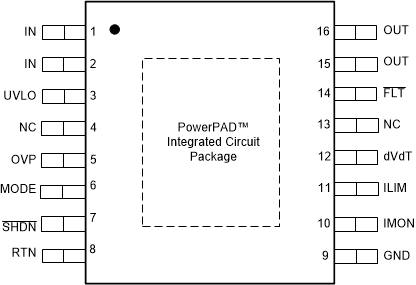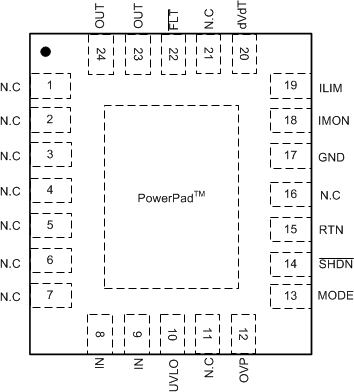SLVSFQ6A November 2020 – June 2021 TPS2640
PRODUCTION DATA
- 1 Features
- 2 Applications
- 3 Description
- 4 Revision History
- 5 Device Comparison
- 6 Pin Configuration and Functions
- 7 Specifications
- 8 Parameter Measurement Information
-
9 Detailed Description
- 9.1 Overview
- 9.2 Functional Block Diagram
- 9.3
Feature Description
- 9.3.1 Undervoltage Lockout (UVLO)
- 9.3.2 Overvoltage Protection (OVP)
- 9.3.3 Reverse Input Supply Protection
- 9.3.4 Hot Plug-In and In-Rush Current Control
- 9.3.5 Overload and Short Circuit Protection
- 9.4 Device Functional Modes
-
10Application and Implementation
- 10.1 Application Information
- 10.2 Typical Application
- 10.3 System Examples
- 10.4 Do's and Dont's
- 11Power Supply Recommendations
- 12Layout
- 13Device and Documentation Support
- 14Mechanical, Packaging, and Orderable Information
Package Options
Mechanical Data (Package|Pins)
Thermal pad, mechanical data (Package|Pins)
- PWP|16
Orderable Information
6 Pin Configuration and Functions
 Figure 6-1 PWP Package 16-Pin HTSSOP Top View
Figure 6-1 PWP Package 16-Pin HTSSOP Top View |
 Figure 6-2 RHF Package 24-Pin VQFN Top View
Figure 6-2 RHF Package 24-Pin VQFN Top View |
| PIN |
TYPE |
DESCRIPTION | ||
|---|---|---|---|---|
| NAME |
TPS26400 |
|||
| HTSSOP |
VQFN |
|||
|
dVdT |
12 |
20 |
I/O |
A capacitor from this pin to RTN sets output voltage slew rate See the Hot Plug-In and In-Rush Current Control section. |
| FLT |
14 |
22 |
O |
Fault event indicator. It is an open drain output. If unused, leave floating. |
|
GND |
9 |
17 | — |
Connect GND to system ground. |
|
ILIM |
11 |
19 |
I/O |
A resistor from this pin to RTN sets the overload and short-circuit current limit. See the Overload and Short Circuit Protection section. |
|
IMON |
10 |
18 |
O |
Analog current monitor output. This pin sources a scaled down ratio of current through the internal FET. A resistor from this pin to RTN converts current to proportional voltage. If unused, leave it floating. |
|
IN |
1 |
8 |
Power |
Power input and supply voltage of the device. |
|
2 |
9 |
|||
|
MODE |
6 |
13 |
I |
Mode selection pin for over load fault response. See the Device Functional Modes section. |
|
N.C |
4 |
1-7 |
— |
No connect. |
|
11 |
||||
|
13 |
16 |
|||
|
21 |
||||
|
OUT |
15 |
23 |
Power |
Power output of the device. |
|
16 |
24 |
|||
|
OVP |
5 |
12 |
I |
Input for setting the programmable overvoltage protection threshold. An overvoltage event turns off the internal FET and asserts FLT to indicate the overvoltage fault. Connect OVP pin to RTN pin externally to select the Factory set V(IN) overvoltage trip level. See Overvoltage Protection (OVP) section. |
|
PowerPadTM |
— | — | — |
PowerPad must be connected to RTN plane on PCB using multiple vias for enhanced thermal performance. Do not use PowerPad as the only electrical connection to RTN. For Programmable overvoltage clamp, connect the resistor ladder from Vout to OVP to RTN. |
|
RTN |
8 |
15 |
— |
Reference for device internal control circuits. |
|
SHDN |
7 |
14 |
I |
Shutdown pin. Pulling SHDN low makes the device to enter into low power shutdown mode. Cycling SHDN pin voltage resets the device that has latched off due to a fault condition. |
|
UVLO |
3 |
10 |
I |
Input for setting the programmable undervoltage lockout threshold. An undervoltage event turns off the internal FET and asserts FLT to indicate the power-failure. Connect UVLO pin to RTN pin to select the internal default threshold. |